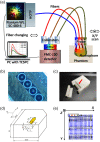Reconstruction of fluorophore absorption and fluorescence lifetime using early photon mesoscopic fluorescence molecular tomography: a phantom study
- PMID: 36519075
- PMCID: PMC9743783
- DOI: 10.1117/1.JBO.27.12.126001
Reconstruction of fluorophore absorption and fluorescence lifetime using early photon mesoscopic fluorescence molecular tomography: a phantom study
Abstract
Significance: Fluorescence molecular lifetime tomography (FMLT) plays an increasingly important role in experimental oncology. The article presents and experimentally verifies an original method of mesoscopic time domain FMLT, based on an asymptotic approximation to the fluorescence source function, which is valid for early arriving photons.
Aim: The aim was to justify the efficiency of the method by experimental scanning and reconstruction of a phantom with a fluorophore. The experimental facility included the TCSPC system, the pulsed supercontinuum Fianium laser, and a three-channel fiber probe. Phantom scanning was done in mesoscopic regime for three-dimensional (3D) reflectance geometry.
Approach: The sensitivity functions were simulated with a Monte Carlo method. A compressed-sensing-like reconstruction algorithm was used to solve the inverse problem for the fluorescence parameter distribution function, which included the fluorophore absorption coefficient and fluorescence lifetime distributions. The distributions were separated directly in the time domain with the QR-factorization least square method.
Results: 3D tomograms of fluorescence parameters were obtained and analyzed using two strategies for the formation of measurement data arrays and sensitivity matrices. An algorithm is developed for the flexible choice of optimal strategy in view of attaining better reconstruction quality. Variants on how to improve the method are proposed, specifically, through stepped extraction and further use of a posteriori information about the object.
Conclusions: Even if measurement data are limited, the proposed method is capable of giving adequate reconstructions but their quality depends on available a priori (or a posteriori) information. Further research aims to improve the method by implementing the variants proposed.
Keywords: Monte Carlo method; early arriving photons; fluorescence lifetime; fluorescence molecular tomography; phantom with fluorophore; reconstruction algorithm.
© 2022 The Authors.
Figures










References
-
- Chen Y., et al. , “Integrated optical coherence tomography (OCT) and fluorescence laminar optical tomography (FLOT),” IEEE J. Sel. Top. Quantum Electron. 16(4), 755–766 (2010).IJSQEN10.1109/JSTQE.2009.2037723 - DOI

